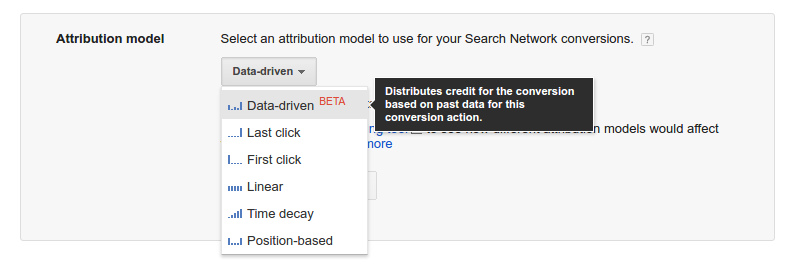The Death of Last Click Attribution & Rise of Google's Data Driven Model

In ecommerce, attribution can be a complicated concept for retailers to understand. In simple terms, an attribution model is the rule, or set of rules, that determine how credit for sales and conversions are assigned to touchpoints in the conversion path.
Touchpoints can vary from email, to social media, SEO and PPC. But overall, it’s imperative for advertisers to understand how each of these channels relate and support each other throughout the shopper’s journey.
Although the concept of attribution is nothing new – it was one of (if not the most prominent) topic discussed at the Search Marketing Expo (SMX) in New York this year.
 “Attribution is essentially assigning value to your campaigns. But what we are seeing in today’s world of digital commerce is that the average transaction has more than 30 touchpoints in it,” Lewis Brannon, Paid Search Manager at CPC Strategy said.
“Attribution is essentially assigning value to your campaigns. But what we are seeing in today’s world of digital commerce is that the average transaction has more than 30 touchpoints in it,” Lewis Brannon, Paid Search Manager at CPC Strategy said.
For example, if you are buying a new pair of jeans, it’s likely you will conduct quite a bit of research before you decide to convert.
You might type in multiple searches (on various devices), visit a dozen or more websites, click on 10 to 15 ads and browse pages of product reviews for feedback.
“Customers can engage in all of these different touchpoints before they ultimately make a purchase,” Brannon said.
Below is an example to help explain how each of the attribution models apply to a conversion:
“Selena finds teeki.com (a yoga apparel company) by clicking one of it’s AdWords ads. She returns one week later by clicking over from Facebook. That same day, she comes back a third time via one of Teeki’s email campaigns, and a few hours later, she returns again directly and buys a pair of floral yoga pants.

https://tinuiti.com/blog/2015/08/attribution-modeling-google-analytics/
According to Google, “For each conversion type, use a simple drop-down menu in Conversionsettings to select one of six different attribution models — last click, first click, linear, time decay, position-based, or data driven.”
“When you pick a new model, credit will be reassigned across the conversion path for all search or shopping ad clicks on Google.com, and your conversion stats will change moving forward. You can adjust bids based on your new way of counting conversions, and if you’re using automated bidding for search ads, your bids will be optimized automatically to reflect your new model.”
Now you may notice a new attribution model: Data-driven, which we will talk about in more detail later on in the post.
It’s vital that advertisers have access to models and evaluation platforms that allow them to see not just how the last click contributed to the purchase but how all of the touchpoints contributed along the entire shopper’s journey.
That way, when you are analyzing the ROI of individual campaigns (for example: “how well did my Google Shopping non-brand campaign do this month?) You have a better understanding of your campaign performance as a whole.
“For example: A retailer might see that one of their campaigns has a .7:1 return. To the retailer, it appears this particular campaign isn’t doing well, so they might think it’s best to pause it and reallocate that money to a different campaign with a better return (example 5:1 ROI).
A good way to think about attribution is to visualize a basketball game. A point guard getsa pass from his teammate, then he shoots and scores. The point guard gets the recognition for the points on the scoreboard but the reality is – if his teammate never passed him the ball – it’s likely he never would have had the opportunity to shoot in the first place.
So, in this scenario the point guard is the branded text ad and if we’re following the last click attribution model – unfortunately his teammate gets zero credit for the pass and looks like he’s not a good player judging by the hard numbers.
If your paths to purchase are direct enough, the default last-click approach may be the right choice but the reality – this is usually not the case.
“The good news is AdWords has taken a lot of steps to provide advertisers with more of those ‘big picture’ metrics. For example, now we can add a column for an “assisted conversion”, Brannon said.
Thanks to the attribution modeling section, advertisers can see how their campaigns stack up and compare different attribution models together. You can look at last click vs. first click: For example one campaign could perform poorly according to last click but if you look at the first click model – it’s actually doing a really good job of introducing traffic (hence the basketball teammate passing the ball). Of course, the real question is how can retailers get the true value out of all these campaigns?
One of the latest models introduced to help advertisers gain a better understanding of attribution is Google’s Data-driven model.
According to the announcement, for the first time, AdWords advertisers with sufficient data will also be able to select the new data driven attribution model as a public beta, which is also available in Analytics 360, Attribution 360, and DoubleClick.
Unlike rules-based models, data driven attribution uses machine learning to evaluate all the converting and non-converting paths across your account and identifies the proper credit for each interaction.
The model considers:
“This is Google’s attempt to build an all encompassing attribution measurement that can be applied to campaigns and immediately start providing actionable data,” Brannon said.
“In other words, Data-driven looks at all the clicks on your search ads, then it compares the click paths of customers who convert vs. the click path of customers who don’t. The model identifies patterns of clicks that lead to conversions and then they basically overlay that onto your campaigns they tell you how valuable your campaigns are based on this wide array of search behavior.”
For more on data-driven & other attribution models, email [email protected]
